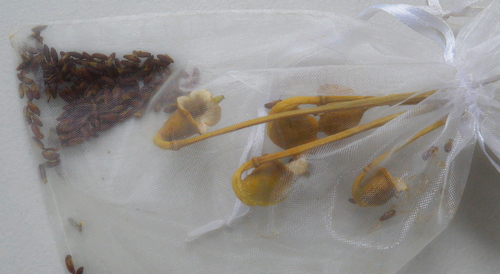
(Jefferson-ee-a dy-FIL-uh)
General Information:
Jeffersonia diphylla is uncommon both in the wild and in gardens. It starts early in spring with purplish new growth that opens with white flowers long before leaves show on deciduous trees. Unfortunately the flowers only last a few days. Its real beauty comes next as the blue-green leaves develop. The shape of these is very unusual and look as if someone has pasted two leaves together, hence the name diphylla.
Jeffersonia diphylla :photo by Robert Pavlis
This is a very typical shade plant, that grows quick in spring to gather some sun light, and then enjoys as shady, cool summer under deciduous trees. It prefers a moist location, but I grow it in a dry area, that gets full noon day sun, and it seems to enjoy the spot. If it gets too dry it will go underground in late summer, but my plant seems to keep its leaves all summer long.
Jeffersonia diphylla, spring buds :photo by Robert Pavlis
Common names include, twinleaf, helmet pod and ground squirrel pea. The name twinleaf obviously refers to the leaves. Helmet pod is a good description of the seed pod, which stick straight up, but is shorter than the leaves. As it dries and releases the seeds, it curves over and starts looking more like a pipe.
Jeffersonia diphylla :photo by Robert Pavlis
There are two species in the genus Jeffersonia, the other being J. dubia, with light lavender blooms.
Jeffersonia diphylla, collecting seed in an organza bag :photo by Robert Pavlis
Jeffersonia diphylla, dry seed and pipe-like seed pod :photo by Robert Pavlis
Jeffersonia seeds are hydrophilic and the embryo will die if seed dries out. Sowing the seeds before any drying takes place is the best approach. However, if they are to undergo a period of storage, they are first allowed to dry a bit and then are sealed in a plastic bag in slightly moist vermiculite.
Life Cycle: perennial
Height: 45cm (18in)
Bloom Time: early spring
Natural Range: Eastern North America
Habitat: damp woodlands
Synonyms: none
Cultivation:
Light: part to full deciduous shade
Soil: rich organic soil, limestone
Water: moist to medium
USDA Hardiness Zone: (4?) 5 - 8
Propagation: seed, division
Seedex availability (ORG&HPS annual Seed Exchange): occasionally





